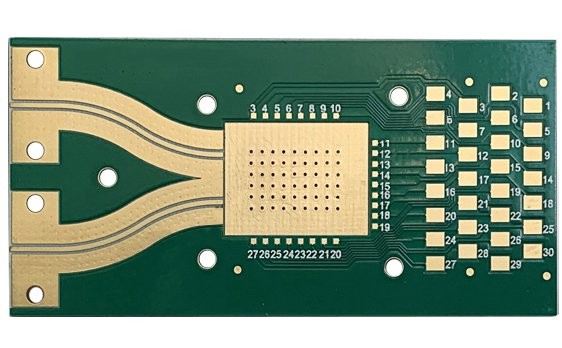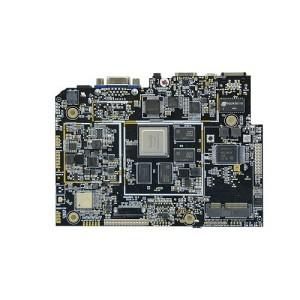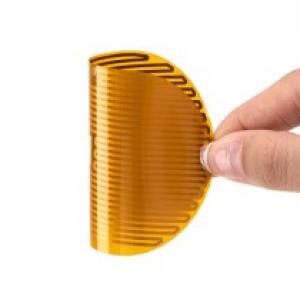Description

A blind hole is a via hole that connects the surface layer and the inner layer but does not penetrate the entire board. It is located on the top and bottom surfaces of a printed circuit board and has a certain depth. It is used for the connection between the surface layer circuit and the inner layer circuit below. The depth of the via hole usually does not exceed a certain ratio (via hole diameter). In PCB design, one side of a blind via hole is on the surface of the board and then extends to the interior of the board.
The main function of a blind via hole is to connect the copper foils on the surface layer and inner layers in high-speed PCB design to achieve electrical connection. It can reduce the number of PCB layers, increase the density and reliability of the PCB, and also reduce costs. Blind holes are usually used to connect circuits at different levels, providing electrical connection and mechanical support.
During the PCB manufacturing process, the production of blind via holes requires the use of special processes and equipment. Generally, the manufacturing process of blind holes includes steps such as drilling and copper plating. During the drilling process, the depth and diameter of the drilling need to be controlled to ensure the quality and reliability of the blind via hole. During the copper plating process, it is necessary to ensure the thickness and uniformity of the copper foil to improve the conductive performance of the blind hole.
What are the classifications of blind via holes in PCB?
The main classifications of blind via holes in PCB are as follows:
1. Laser blind via holes: Formed through laser drilling technology, usually with a smaller aperture and higher precision, suitable for PCB designs with high-density wiring.
2. Mechanical blind via holes: Machined using mechanical drilling equipment, with a relatively larger aperture, generally used in PCBs where extremely high precision is not required.
3. First-order blind via holes: Connect two adjacent layers of the PCB.
4. Second-order blind via holes: Connect two layers in the PCB that are not adjacent but separated by one layer.
5. Multi-order blind via holes: Connect PCB layers that are separated by multiple layers.
These classifications are mainly based on factors such as the drilling method, aperture size, and the PCB layers being connected.
How to Design Blind via Holes in PCB?
The design of blind via holes in PCB usually requires considering the following key steps:
1. Plan the blind via hole circuit layout: Before starting to design blind via holes, a detailed plan for the entire PCB circuit layout is necessary. Determine which signals need to be connected through blind via holes, as well as the location and quantity of blind via holes.
2. Select the appropriate blind via hole type and size: Based on the performance requirements of the circuit and the capabilities of the PCB manufacturing process, select the appropriate blind via hole type (such as laser drilling or mechanical drilling), as well as the diameter and depth. Smaller blind via hole sizes can increase wiring density but may increase manufacturing difficulty and cost.
3. Consider blind via hole PCB signal integrity: Ensure that the design of blind holes does not adversely affect signal integrity. This includes controlling the impedance matching of blind holes, reducing signal reflection and crosstalk, etc. Simulation software can be used to analyze and optimize the electrical performance of blind holes.
4. Stack-up design of blind via hole PCB: Reasonably design the stack-up structure of the PCB to accommodate the connection requirements of blind via holes. Different stack-up materials and thicknesses will affect the performance of blind via holes.
5. Communicate with the blind via hole PCB manufacturer: During the design process, communicate closely with the PCB manufacturer to understand their manufacturing capabilities and process limitations. The manufacturer can provide advice and feasibility evaluations on the blind via hole design.
6. Routing rules: Follow specific routing rules, such as minimum line width, spacing, and trace angle, to ensure smooth connection of blind via holes to surrounding traces and meet electrical performance requirements.
7. Simulation and verification: Use professional PCB design simulation tools to simulate and verify the signal integrity, power integrity, and thermal performance of the PCB containing blind via holes. Optimize and adjust the blind via hole design based on the simulation results.
8. Document record: Document the design parameters and requirements of blind via holes in detail for quality control during the manufacturing process and subsequent maintenance and improvement.
It should be noted that the design of blind via holes is a complex process that requires comprehensive consideration of multiple factors such as electrical performance, manufacturing process, and cost to achieve a high-quality and high-performance PCB design.
1. Careful layout planning: At the early stage of design, conduct a reasonable layout of the circuit, minimize the quantity and complexity of blind via holes as much as possible, and ensure that the positions and connections of blind holes are in line with the signal flow and functional requirements.
2. Strict control of aperture and depth: Based on the capabilities of the PCB manufacturing process and design specifications, select the appropriate aperture and depth of blind via holes. Blind via holes that are too small or too deep may cause manufacturing difficulties and unstable performance.
3. Consider material characteristics: Choose PCB substrate materials suitable for blind via hole manufacturing to ensure their stability and reliability during the drilling and copper plating processes.
4. Conduct signal integrity analysis: At the design stage, use professional software for signal integrity analysis to predict the possible impact of blind via holes on signal transmission and optimize the design accordingly.
5. Follow design rules: Strictly follow the general rules of PCB design, including line width, spacing, inter-layer distance, etc., to reduce interference between blind via holes and other lines.
6. Work closely with the manufacturer: During the design process, maintain communication with the PCB manufacturer, understand their manufacturing capabilities and process limitations, and adjust the blind via hole design based on the manufacturer's suggestions.
7. Thermal management: Consider the influence of the distribution of blind via holes on the PCB on heat dissipation to avoid local overheating problems caused by the concentration of blind via holes.
8. Optimization of multilayer board design: In the design of multilayer PCBs, arrange the layers where blind via holes are located reasonably to reduce inter-layer interference and improve electrical performance.
9. Testing and verification: At the prototype production stage, conduct strict testing and verification on the PCB containing blind via holes to discover and solve possible problems in a timely manner.
Application Cases of Blind Via Holes in High-Speed PCB Design
The following are some application cases of blind via holes in high-speed PCB design:
Case One: Smartphone Motherboard Design
Smartphones need to achieve high integration and high performance within a limited space. By using blind via hole technology, lines on different layers can be connected to achieve tighter wiring. For example, connecting the inner layer lines where the processor and memory chips are located with other components on the outer layer can improve signal transmission efficiency and reduce signal delay without increasing the overall thickness of the PCB.
Case Two: Graphics Processing Card Design
Graphics processing cards have high requirements for data transmission speed. Blind via holes can be used to connect the lines of different functional modules in a multi-layer PCB, such as the high-speed signal lines between the GPU core and the video memory. This can shorten the signal transmission path, reduce transmission loss, and thereby improve the performance and response speed of graphics processing.
Case Three: High-Speed Server Motherboard Design
Servers need to handle large amounts of data and high-speed network communication. Blind via holes help reduce the space occupation and signal interference caused by through via holes. For example, when connecting key components such as high-speed network chips and memory controllers, the use of blind via hole design can optimize wiring and improve signal integrity and system stability.
Case Four: Tablet Computer Design
Tablet computers pursue portability, thinness, and high performance. Blind via hole technology can achieve more line connections within the limited PCB space, making the communication between each functional module more efficient. At the same time, it helps reduce the number of layers and the thickness and weight of the PCB.
In these application cases, the use of blind via holes brings many benefits, including:
1. Improving wiring density of blind via hole PCB, allowing more signal lines to be wired in a limited space, reducing the size of the PCB, and improving system integration.
2. Reducing signal transmission delay and loss blind via hole PCB, improving circuit performance and response speed.
3. Enhancing the reliability and stability of the blind via hole PCB, reducing the stress and distortion of the PCB board, and improving the system's anti-interference ability.
However, when applying blind via hole technology, it is necessary to pay attention to reasonable planning of blind via hole positions, selection of appropriate sizes and diameters, ensuring correct manufacturing processes and parameters, and conducting simulation and verification to ensure compatibility with other design requirements. At the same time, different PCB manufacturers may have different design requirements and recommendations, and communication with the manufacturer during the design process is also very important.






